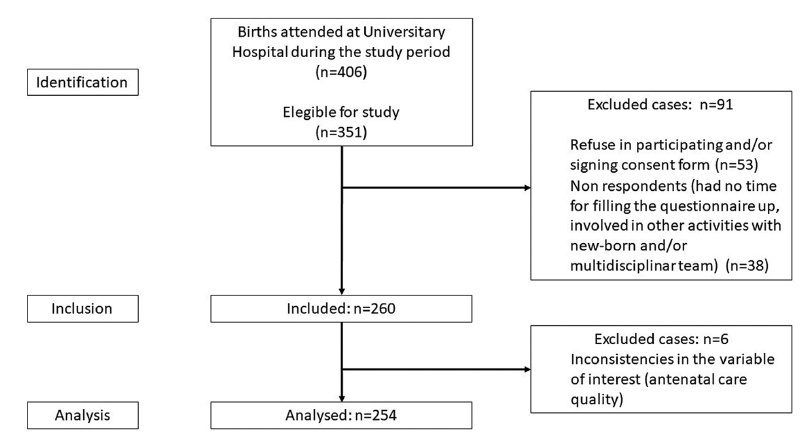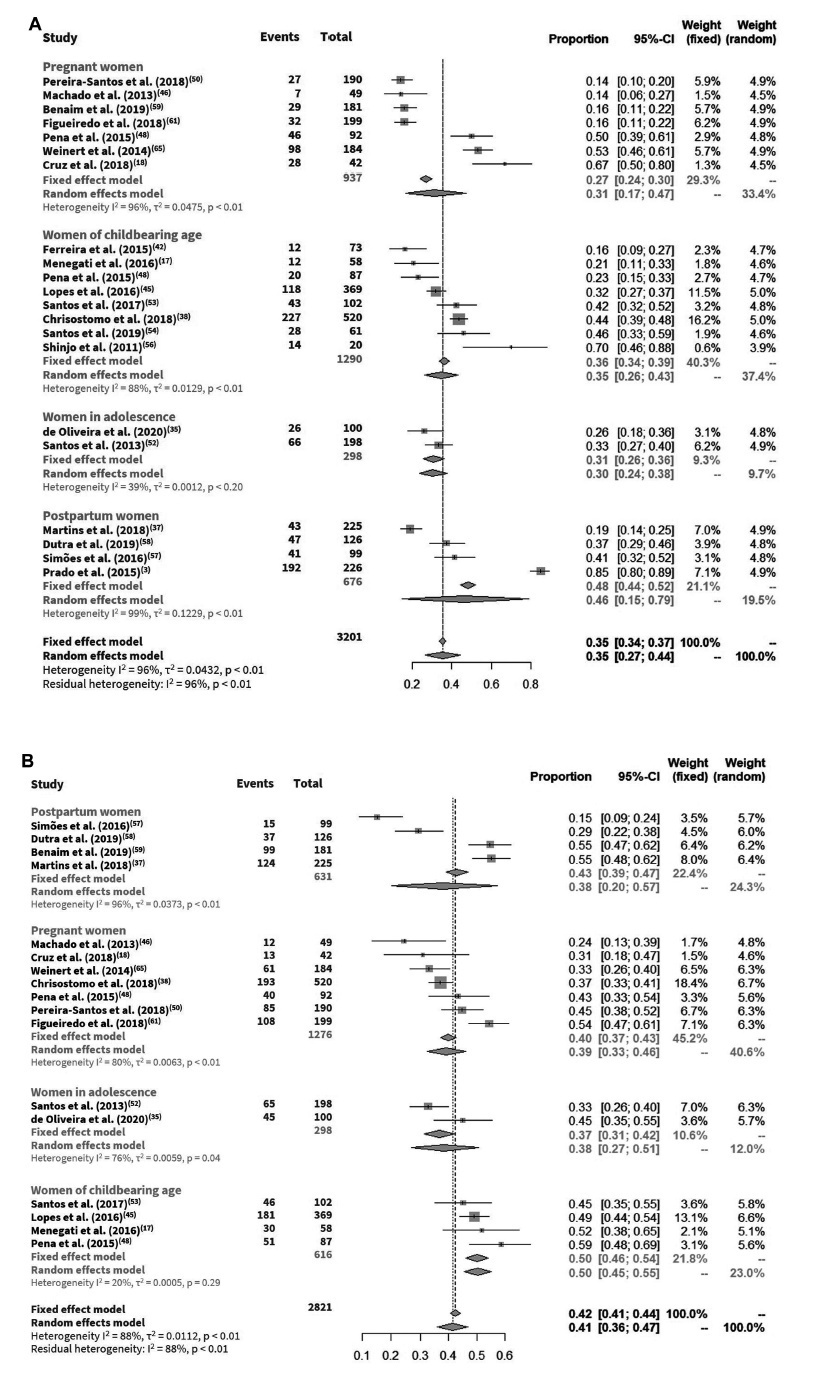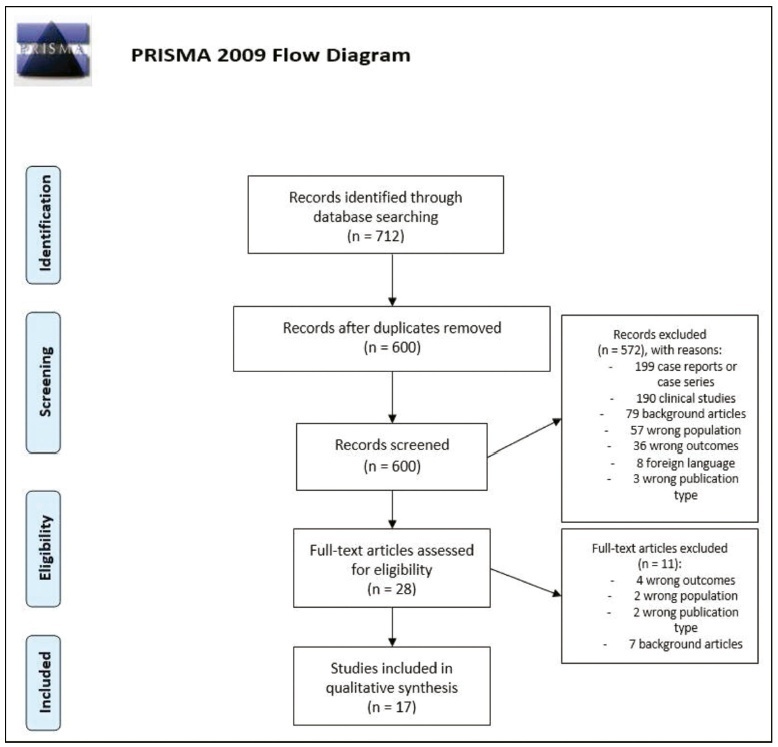Summary
Revista Brasileira de Ginecologia e Obstetrícia. 2022;44(4):385-390
To evaluate the role of cervical cytology (Pap smear) in the diagnosis of cervical intraepithelial neoplasia 2 or greater (CIN2+), presented exclusively in the endocervical canal, the clinical-epidemiological characteristics of this lesion, the necessary length of canal to be removed to treat, and the rate of invasive lesion hidden in the endocervical canal.
Cross-sectional study, by database analysis, of patients with abnormal cytology (high-grade squamous intraepithelial lesion [HSIL]), without visible colposcopy lesion, submitted to loop electrosurgical procedure (LEEP) to evaluate the association of cytology results with the histological product of the conization, to identify the epidemiological characteristics of endocervical lesion and clinical evolution, using a pvalue< 0.05 and 95% CI.
In 444 cases, the Pap smear sensitivity for CIN2+ diagnosis was 75% (95% CI: 69.8-79.7), specificity was 40% (95% CI: 30.2-49.5), and the prevalence rate of histological lesion was 73% (95% CI: 70.1-78.7). There was a higher prevalence of CIN2+ in women over 42 years old and invasive cancer in those over 56 years old (p<0.001), and it was necessary to remove 2.6 cm in length of the canal to reduce the chance of recurrence (p<0.006). The rate of invasive cancer was 2.7%.
Cytology was related to a high prevalence to histological lesion (73%) in the diagnosis of CIN2+ in the endocervical disease; older patients presented a higher relationship with histological lesions in the canal disease, and it was necessary to remove an average of 2.6 cm in length of the endocervical canal to avoid the persistence and progression of CIN. The rate of occult neoplasia in the endocervical canal was 2.7%.
Summary
Revista Brasileira de Ginecologia e Obstetrícia. 2022;44(4):391-397
To determine knowledge, attitude, and preventive (KAP) practices towards the SARS-CoV-2 (COVID-19) pandemic among women in reproductive age seeking to use copper or hormonal intrauterine devices (IUD/LNG-IUS).
We conducted a cross-sectional study in which we applied a questionnaire on 400 women about KAP practices on COVID-19 at the University of Campinas, Campinas, SP, Brazil, from May to August 2020.
The mean (±SD) age of the women was 30.8±7.9 years, and 72.8% of them reported being pregnant at least once. Most women (95%) had heard or read about COVID-19, and their main sources of information were television (91%) and government websites (53%). However, 53% of the women had doubts about the veracity of the information accessed.
Women without a partner and with>12 years of schooling had more information about COVID-19 and on its impact on new pregnancy, and those from high socioeconomic status had a higher chance of maintaining physical distance. Safety, effectiveness, comfort, and absence of hormone in the contraceptive method (in the case of TCu380A IUD) were the main reasons for the participants to seek the service during the pandemic, and the possibility to stop menstrual bleeding was the main reason to choose the LNG-IUS.
Summary
Revista Brasileira de Ginecologia e Obstetrícia. 2022;44(4):398-408
The present study aimed to evaluate the antenatal care adequacy for women who gave birth at the University Hospital of Santa Catarina in Florianopolis (Brazil) during the COVID-19 pandemic, and to evaluate the association of adequacy with sociodemographic, clinical, and access characteristics.
Data were collected between October and December 2020, including 254 patients who delivered in the University Hospital from Federal University of Santa Catarina and answered our questionnaires. Additional data were obtained from patients’ antenatal booklets. Antenatal care was classified as adequate, intermediate, or inadequate according to the number of appointments, gestational age at the beginning of follow-up, and tests results. We carried out a descriptive statistical analysis and a bivariate/with odds ratio analysis onmaternal sociodemographic, clinical and health access variables that were compared with antenatal adequacy.
Antenatal care was considered adequate in 35.8% of cases, intermediate in 46.8%, and inadequate in 17.4%. The followingmaternal variables were associated with inadequate prenatal care (intermediate or inadequate prenatal care): having black or brown skin colour, having two or more children, being of foreign nationality, not being fluent in Portuguese, and using illicit drugs during pregnancy; the clinical variables were more than 6 weeks between appointments, and not attending high-risk antenatal care; as for access, the variables were difficulties in attending or scheduling appointments, and attending virtual appointments only.
In a sample of pregnant women from a teaching hospital in Florianópolis during the COVID-19 pandemic, antenatal care was considered adequate in 35.8%, intermediate in 46.8%, and inadequate in 17.4% of cases.

Summary
Revista Brasileira de Ginecologia e Obstetrícia. 2022;44(4):409-424
To estimate the prevalence of inadequate vitamin D level and its associated factors for women of childbearing age in Brazil.
A systematic reviewwas conducted (last updatedMay 2020).Meta-analyses were performed using the inverse-variance for fixed models with summary proportion calculation by Freeman-Tukey double arcsine. Reporting and methodological quality were assessed using the Joanna Briggs Institute tool for prevalence studies.
Our review identified 31 studies, comprising 4,006 participants. All the studies had at least one weakness, mainly due to the use of convenience sampling and small sample size. The overall prevalence of vitamin D deficiency, insufficiency, and both deficiency and insufficiency were 35% (confidence interval, 95%CI: 34-37%), 42% (95%CI: 41-44%), and 72% (95%CI: 71-74%), respectively.
Although the magnitude of the prevalence of inadequate levels of vitamin D is uncertain, the evidence suggests that presence of vitamin D deficiency or insufficiency in women of reproductive age can cause moderate to severe problems.

Summary
Revista Brasileira de Ginecologia e Obstetrícia. 2022;44(4):425-433
Diagnosing polycystic ovary syndrome (PCOS) during adolescence is challenging since normal pubertal development overlap typical features of this syndrome. The authors aim to summarize the existing evidence concerning PCOS in adolescence, particularly its diagnostic criteria and therapeutic options. A search throughout medical databases such as PubMed and MedScape was performed. Diagnostic criteria include irregular menstrual cycles according to time postmenarche and evidence of clinical hyperandrogenism and/or biochemical hyperandrogenism, provided other causes have been excluded. Polycystic ovarianmorphology ought not to be used as a diagnostic criterion. Treatment should targetmanifestations and/or comorbidities, even in the absence of a definite diagnosis. Lifestyle interventions are the first-line treatment. Combined oral contraceptives, metformin or antiandrogens may also be considered as adjuvants. Screening for PCOS in adolescence is crucial as it allows an early intervention on the symptoms and comorbidities presented leading to better long-term reproductive and metabolic outcomes.

Summary
Revista Brasileira de Ginecologia e Obstetrícia. 2022;44(4):435-441
Antenatal recognition of severe cases of congenital diaphragmatic hernia (CDH) by ultrasound (US) and magnetic resonance imaging (MRI) may aid decisions regarding the indication of fetal endoscopic tracheal occlusion.
An integrative review was performed. Searches in MEDLINE and EMBASE used terms related to CDH, diagnosis, MRI, and US. The inclusion criteria were reviews and guidelines approaching US and MRI markers of severity of CDH published in English in the past 10 years.
The search retrieved 712 studies, out of which 17 publications were included. The US parameters were stomach and liver positions, lung-to-head ratio (LHR), observed/expected LHR (o/e LHR), and quantitative lung index. The MRI parameters were total fetal lung volume (TFLV), observed/expected TFLV, relative fetal or percent predicted lung volumes, liver intrathoracic ratio, and modified McGoon index. None of the parameters was reported to be superior to the others.
The most mentioned parameters were o/e LHR, LHR, liver position, o/e TFLV, and TFLV.

Summary
Revista Brasileira de Ginecologia e Obstetrícia. 2022;44(4):442-447